by bria4123 on October 27, 2012
Florence in the Renaissance influenced Western culture as much as Athens, Rome, Paris and London did. 3 dimensional perspective was theorized there. And no building had more impact on Florence than Orsanmichele.
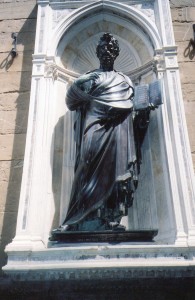
Sculptures, like Lorenzo Ghiberti’s St. Matthew (above), helped usher in perspectives that we take for granted today. We’ll examine it and compare it with another culture to see more of its beauty. [click to continue…]
by bria4123 on October 25, 2012
I’ve been looking forward to this one!
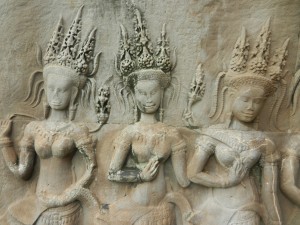
More than 2,000 female dancers called apsaras grace Angkor Wat’s walls. So during this last trip to Cambodia, I took pictures of so many that smoke was coming from my camera. Not just because I enjoy looking at them more than the hulking men in the last post. They have subtle meanings that take you into ideas behind Angkor Wat. They also make very cool comparisons with Western culture. [click to continue…]
by bria4123 on October 25, 2012
The Church of Orsanmichele was in the thick of it. It was, and still is, on the main street that leads from Florence’s cathedral to the main plaza. So when Florence’s governors decreed that Orsanmichele’s outside niches be filled with sculptures, everyone would see these art works on a daily basis.
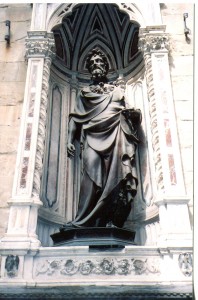
They were destined to become some of the West’s most influential art works. Most were fashioned at the beginning of the 15th century, and they influenced all the great painting and sculpture that came from Florence throughout the Renaissance. A closer look at them not only takes you into key roots of Western civ–it’s a great point of comparison with other cultures. Yeah, the guy in the photo looks heavy and intense, if you look closely, you can fly higher than the dome on Florence’s cathedral. [click to continue…]
by bria4123 on October 24, 2012
Dear Lord, let the people you love most live in this land! I often saw where this old Bavarian prayer was coming from while savoring its beautiful mountains and old towns.
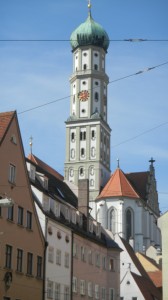
Of Bavaria’s towns, Augsburg has been one of the most prosperous. Even in the Middle Ages, visitors spread word about its riches. It was a key trading hub between Italy and the rest of Germany, so some very cool things happened there when the Italian Renaissance blossomed. [click to continue…]
by bria4123 on October 24, 2012
Venice has been a hallmark of Western culture, but it’s also been a place apart.
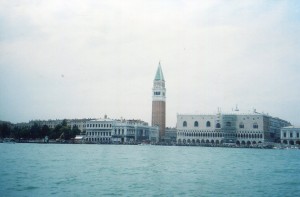
It’s reassuringly familiar on one hand–we’ve all seen thousands of pictures of it. But it also seems mysterious. We’ll gain a bigger perspective of it in the final post in this series. [click to continue…]
by bria4123 on October 23, 2012
The great early 16th century German painter Albrecht Durer wrote that Italy has some of the world’s most enjoyable people, and some of its worst scoundrels. Did the Venice that he studied in for 2 years have its share of Pavarotti’s and Berlusconi’s, or was he feeling culture shock? The town he was from, Nuremberg, was dominated by plain and hard-working merchants. But he was now seeing more color and variety than he ever had, and maybe he was thinking in terms of extremes, like a lot of bewildered new immigrants.
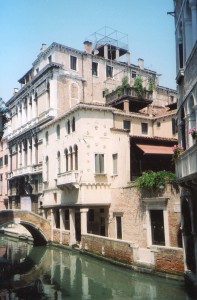
Venice fascinated a lot of people during the Renaissance. Shakespeare portrayed it as a bastion of civilization in Othello. Ben Jonson used it for the setting of his dark comedy Volpone, which wickedly lampoons human greed (it should be required reading for every finance major). Venice still captivates millions of tourists. So we’ll look beneath its glittering surfaces–into what people were thinking in those densely packed homes, and into Venice’s impact on Western culture. [click to continue…]
by bria4123 on October 22, 2012
Venetians had many reasons to celebrate as they entered the Renaissance. In 1380 they won a final victory over Genoa–their long-time rival for sea trade. In 1405 they took control of the great medieval city of Padua–the first stage of their growing land-based empire. They developed a huge merchant fleet, and it put it to good use.
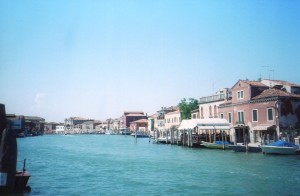
Venice was one of Europe’s manufacturing centers, and its ships carried its products through the west and the east. Venice especially valued its glass making, which was centered on the smaller island of Murano (above). Venetians were proud of becoming one of Europe’s main economic forces, and they were about to project their identities by creating art that made their city one of the West’s main cultural forces. [click to continue…]
by bria4123 on October 21, 2012
I arrived at the turning point in the steps between the outer and inner dome of Florence’s Cathedral. As I climbed, the dome’s angle of ascent decreased to 45 degrees, so now the stairway turned 90 degrees and followed the vault’s ribs directly to the center.
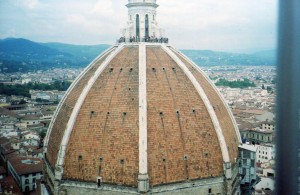
It was so cool to be between the two massive domes which were built almost 600 years ago. But when I reached the observation platform, I had a revelation. [click to continue…]
by bria4123 on October 21, 2012
I’ve been writing a lot of posts about Southeast Asia since I returned home from there, and rivers have helped shape much of the region’s thought. So here’s a reflection from Western currents.
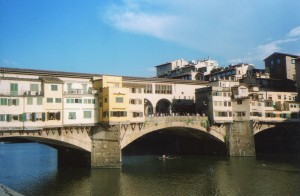
Florence’s Ponte Vecchio spans the Arno river at its narrowest part. Ancient Romans had built a bridge there, but the river’s frequent floods destroyed many bridges from Roman and medieval times. The lowest part of the structure in the picture was constructed in the 14th century. But I find the buildings on top of it most interesting. [click to continue…]
by bria4123 on October 20, 2012
OK, I said that I don’t have a snake fetish. But if you’ve been reading my blog lately, you might think that I have an Angkor Wat fetish.
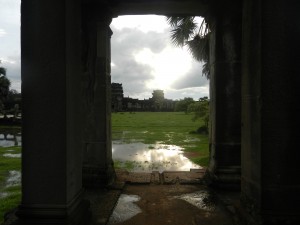
I’ve been writing a lot about Angkor Wat and snake lore in Southeast Asia to immerse you in deep thought patterns of a different culture. These patterns are very deep and creative. The more you explore Southeast Asian societies, the more wealth you’ll find. I found yet another type of wealth while taking the above photo. [click to continue…]










